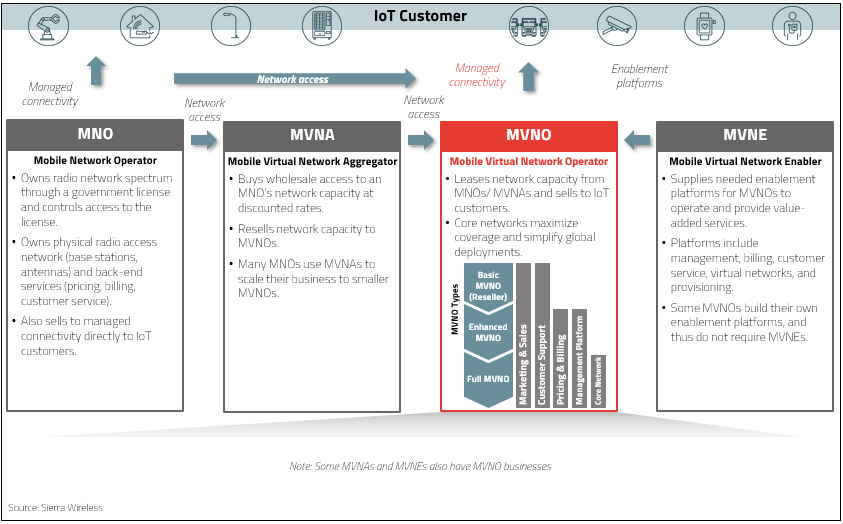August 20, 2022
Connectivity, IoT, Glossary, MVNO

Related Blogs:
Sign up for blog updates
Get innovation delivered to your inbox. Sign up for our blog and stay on top of the very latest from Semtech (formerly Sierra Wireless).
August 20, 2022
Connectivity, IoT, Glossary, MVNO

However, no IoT application, no matter how sophisticated, can deliver value without one crucial aspect: connectivity.
This is where MVNOs come in. But hold on a second – what exactly is an MVNO, and how is it different from an MNO? And is an MVNO the same thing as an MVNA? What about an MVNE – where does that fit into the picture?
It’s a weighty topic, and there’s a sea of acronyms to swim through. Never fear, though: We’ve outlined some of the top questions people have on the subject alongside some helpful answers and explanations. By the end of the post, you’ll be on solid footing with regard to your understanding of MVNOs and what they do – and the foundation they can provide for successful IoT applications.
An MVNO is a mobile virtual network operator. Unlike mobile network operators (MNOs – more on this in a bit), MVNOs typically don’t have their own telecom towers. Instead, MVNOs have access to multiple partners – including MNOs and roaming partners – and then aggregate the services from those different partners into a centralized offering that can aid customers with their IoT use cases by providing connectivity.
An MNO (mobile network operator) is a wireless service provider. Think here of the likes of AT&T, Vodafone, Telstra, NTT Docomo, China Mobile, and other large wireless companies around the globe. These companies actually own the infrastructure and the network towers that deliver their service – consider them the first tier of the telecommunications stack.
Down a level, you have the roaming partners which are typically smaller organizations that work with the MNOs to create services; however, they have a broader roaming footprint. For example, a roaming partner might have a contract with Vodafone, KTF, and Docomo that allows them to use that access to provide comprehensive European and APAC coverage. (An MNO, by contrast, would be limited to providing coverage only in the geographies where they have telecom towers and physical infrastructure).
The third tier of the stack is the MVNOs. They can partner with both MNOs and roaming partners to create aggregated services for customers. As a result, MVNOs typically have a very broad footprint, with global coverage stemming from multiple relationships across MNOs and partners.
As alluded to earlier, one of the main reasons that MVNOs have come about is that they can focus on a greater geographical area and deliver comprehensive coverage to customers in a more seamless manner than an MNO could.
For instance, an MVNO might spy an opportunity to provide customers with a better coverage option for Europe. As a next step, they would then go to the three or four top MNOs in every country and contract with them such that the MVNO’s customer – who's going to be crisscrossing Europe – doesn't need to engage with every MNO in the countries they’re going to be. They can simply contract with the MVNO and use one SIM card (the subscriber identity module that allows them to connect to the network) for connectivity.
As it turns out, there isn’t just one type of MVNO – there are several different flavors.
In essence, MVNOs consume MNO connectivity and technology and then repackage it for customers and their use cases by providing value added services on top of the connectivity.
This is what that looks like in practice… Say a customer has an IoT application. Instead of going to an MNO and getting just the connectivity part, they can go to an MVNO and get not just connectivity, but design support, a security consultation, a device management layer, a SIM management layer – even billing. MVNOs are a one-stop shop for both connectivity and all “the other stuff” that MNOs aren’t in the business of providing.
We discussed earlier how an MNO is a mobile network operator who provides cellular services in a specific country or region and owns their own telecom towers, while an MVNO is someone who partners with MNOs and roaming partners to provide a broader and more flexible coverage footprint.
Consider those roaming partners to be Mobile Virtual Network Aggregators (MVNAs). They are the aggregators that sit between the MNO and the MVNO. An MVNA, for instance, might take coverage from Vodafone, KT, and Docomo, and package it together – or, as their name implies, aggregate it – in a single bundle that it then sells to an MVNO.
Just to keep things interesting, there’s also such thing as a Mobile Virtual Network Enabler (MVNE) – and that's a different kettle of fish than an MVNA. In essence, an MVNE supplies the infrastructure for the MVNO.
While some MVNOs have their own core network and don’t need an MVNE, a smaller MVNO – perhaps one that is just starting up – could go to an MVNE and purchase the infrastructure service from them to help launch their MVNO service.
All of the various entities we’ve been discussing play an important role in the IoT ecosystem and provide a valuable service. But if you’re an IoT customer, your focus should be on an MVNO.
You're not leasing infrastructure, so a MVNE isn’t your destination because you aren’t the customer they serve. Likewise, a MVNA is focused on serving MVNOs – that’s who their customer base is.
A full MVNO, by contrast, is going to provide an end-to-end service to IoT customers: delivering connectivity, helping IoT customers to set up their application firmware, providing security, handling billing, and providing one place to manage everything.

Before choosing an MVNO, customers must first consider the challenges involved with launching an IoT application.
In the IoT, cellular-based deployments typically connect to the network using a SIM originally designed for mobile phones and other consumer devices. Unfortunately, IoT devices behave differently, have different technical requirements, and use different business models than consumer devices. Using traditional SIMs for IoT applications increases complexity and is not an effective long-term solution to connecting billions of IoT devices.
Unlike consumer devices, IoT devices operate independently, most often without human intervention, and may simply stop working if a connection fails. What’s more, IoT devices often need to operate in challenging environments – deep indoors, underground, in rural areas or urban canyons. They may be part of stationary or moving machines, working within a limited geographical region or across continents. Every deployment has its own unique requirements, and these very specific operating constraints add to the SIM challenge.
Using traditional SIMs for IoT connectivity can result in lapses in coverage, interruptions in data transmission, and, ultimately, expensive service calls to rectify the issue. Using multiple service providers helps with coverage, but adds significant complexity and cost in managing multiple vendors, SIMs, and platforms.
Given this array of challenges, there are several important questions customers should ask when choosing an MVNO in order to achieve the best results:
The benefits?
The benefits?
The benefits?
The benefits?
The following Sierra Wireless resources provide more details on connectivity, and how selecting the right connectivity provider can power IoT success:
Start with Sierra by contacting us directly to talk about your IoT connectivity needs, and find out how our Smart Connectivity and other IoT connectivity services can help you unlock value in today’s connected economy.
Get innovation delivered to your inbox. Sign up for our blog and stay on top of the very latest from Semtech (formerly Sierra Wireless).